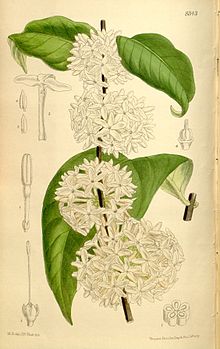Pleiocarpa mutica
Appearance
| Pleiocarpa mutica | |
|---|---|

| |
| Pleiocarpa mutica [1] | |
| Scientific classification | |
| Kingdom: | Plantae |
| Clade: | Tracheophytes |
| Clade: | Angiosperms |
| Clade: | Eudicots |
| Clade: | Asterids |
| Order: | Gentianales |
| Family: | Apocynaceae |
| Genus: | Pleiocarpa |
| Species: | P. mutica
|
| Binomial name | |
| Pleiocarpa mutica | |
| Synonyms[2] | |
| |
Pleiocarpa mutica grows as a shrub or small tree up to 7.5 metres (25 ft) tall, with a stem diameter of up to 5 centimetres (2.0 in). Its fragrant flowers feature a white corolla. Fruit is yellow to bright orange with paired follicles, each up to 2 centimetres (0.79 in) long. The plant is found in a variety of habitats from sea-level to 600 metres (2,000 ft) altitude. Local medicinal uses include as a treatment for stomach-ache, kidney diseases, malaria, jaundice and as a laxative.[3] P. mutica is found in Sierra Leone, Liberia, Ivory Coast, Ghana, Nigeria, Cameroon, the Central African Republic, Gabon and the Republic of Congo.[4]
References
- ^ 1910 illustration from M.S. del., J.N.Fitch lith. - Curtis's Botanical Magazine, London., vol. 136 [= ser. 4, vol. 6]: Tab. 8343
- ^ "Pleiocarpa mutica". The Plant List. Retrieved 18 August 2013.
- ^ Medicinal Plants. PROTA. 2008. pp. 468–469. ISBN 978-9-05782-204-9.
- ^ Search for "Pleiocarpa mutica", World Checklist of Selected Plant Families, Royal Botanic Gardens, Kew, retrieved 18 August 2013
Wikimedia Commons has media related to Pleiocarpa mutica.
Wikispecies has information related to Pleiocarpa mutica.
